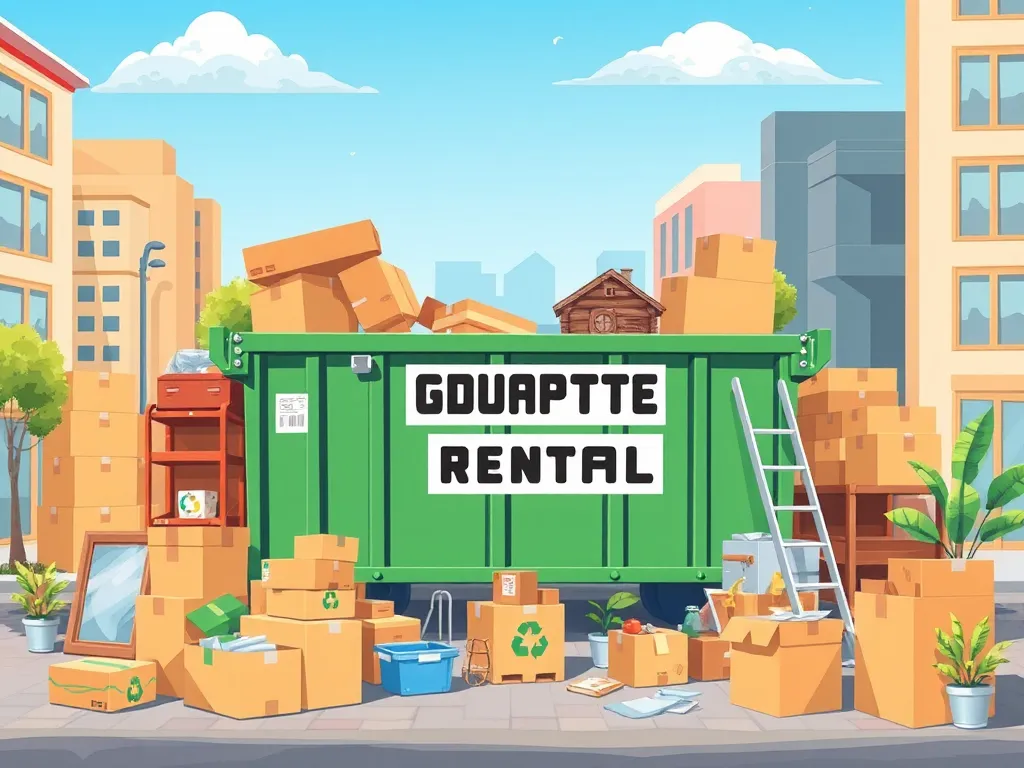Ultimate Guide to Dumpster Rental for Moving Projects

The Ultimate Guide to Dumpster Rental for Moving
Moving can be a daunting task, filled with numerous challenges including packing, heavy lifting, and, importantly, disposing of unwanted items. One effective solution that many people are turning to is dumpster rental moving, which can streamline the process of getting rid of junk during a move.
Dumpster rental moving is not just about convenience; it’s a strategic choice that offers various benefits such as cost-effectiveness, time savings, and eco-friendliness. Whether you are relocating to a new home or downsizing, renting a dumpster can significantly enhance your moving experience by allowing for easy disposal of unwanted items in a systematic manner.
Choosing a dumpster for your moving needs helps organize the decluttering process. You can toss out items en route to your new place, making it easier to manage what stays and what goes. This proactive approach not only clears up space but also reduces the stress related to moving day as you can focus on other essential tasks.
Furthermore, dumpster rental moving promotes responsible waste management. Many companies offer eco-friendly disposal methods, ensuring that recyclable materials are handled correctly. This means that while you are clearing out your old space, you are also contributing positively to the environment by minimizing landfill waste.
In this article, we will cover everything you need to know about dumpster rental moving, including benefits, how to choose the right size, preparation for delivery, what items can be disposed of, the rental process, and how to effectively manage post-move cleanup with a dumpster.
Benefits of Dumpster Rental for Moving
One of the primary benefits of dumpster rental for moving is its cost-effectiveness. Renting a dumpster can often be cheaper than hiring a junk removal service, especially if you have a significant amount of debris or unwanted items. You'll save money on multiple trips to the landfill or disposal site.
Understanding the basics can significantly streamline your home renovation project, so check out What You Need to Know About Residential Dumpster Rentals.
In addition to cost savings, renting a dumpster saves you time. Instead of making several trips to dispose of junk, you can simply throw everything into the dumpster as you pack. This efficiency allows you to focus on getting settled into your new home without wasting countless hours driving back and forth.
Another advantage of dumpster rental moving is its environmental impact. By disposing of waste properly in a dedicated dumpster, you ensure that materials are sorted correctly, with recyclables being diverted from the landfill. Many companies prioritize eco-friendly practices, making it easier for you to contribute to waste reduction efforts during your move.
Moreover, having a dumpster on-site during a move provides unmatched convenience. You won’t have to worry about where to dispose of items as you declutter. The dumpster serves as a central location for waste, making the moving process smoother and less chaotic, as you can quickly toss out anything you decide to part with.
Choosing the Right Dumpster Size
When renting a dumpster, understanding the various sizes available is crucial. Dumpsters typically come in several sizes, from small 10-yard containers suitable for yard waste and small cleanouts to larger 30 or 40-yard containers that can accommodate significant amounts of debris during big moves or renovation projects.
Selecting the right size for your moving needs means considering the volume of junk you expect to discard. If you are moving out of a large home with significant furniture and belongings, opt for a larger dumpster. For studio apartments or single-room moves, a smaller dumpster might be sufficient.
To accurately assess your junk removal requirements, consider conducting a walkthrough of your current home. Take note of any items that you plan to discard and estimate their volume. This will help you choose an appropriate dumpster size without underestimating or overestimating your needs.
Common sizes available for rent include: 10-yard (holds about three pickup truck loads), 20-yard (six pickup truck loads), and 30-yard (nine pickup truck loads). Assessing what items you need to dispose of can shed light on which size is most suitable for your situation.
How to Prepare for Dumpster Delivery
Best practices for preparing your property for dumpster delivery include ensuring that the delivery area is clear of obstacles. This means moving vehicles, outdoor furniture, or other impediments away from where the dumpster will be placed, allowing for easy access for the delivery truck.
Location considerations are essential when it comes to dumpster placement. Ideally, the dumpster should be placed on a flat, stable surface that can support its weight. Avoid placing it on soft ground or overhangs where the weight could cause some shifting or damage.
Be aware of legal permissions and regulations for dumpster placement in your area. It's advisable to contact your local city or municipality to check if permits are required for placing a dumpster in a public space or on the street to avoid possible fines.
Lastly, consider safety tips when preparing for dumpster delivery. Ensure that the delivery area is well-lit and secure. Additionally, make arrangements for children and pets to be kept at a distance during the delivery to avoid any accidents as the dumpster is unloaded.
What to Dispose of in a Moving Dumpster
Items commonly disposed of during a move may include furniture, old appliances, broken electronics, and various household junk. This is an excellent opportunity to declutter, allowing you to recycle or throw away items you no longer need or use.
However, it is crucial to be aware of hazardous waste guidelines for moving. Many items, including paints, chemicals, batteries, and large appliances contain harmful materials and cannot be disposed of in standard dumpsters. Make sure to check with your rental service regarding specific restrictions.
For furniture disposal during a move, consider the condition of the pieces. If they are still usable, look for donation options. If not, ensure they are properly disassembled so that they can fit inside the dumpster effectively, reducing the amount of space they take up.
Recycling options for moving waste should also be considered. Many areas have recycling facilities that accept cardboard, metals, and plastics. This helps keep recyclable materials out of landfills, contributing to your overall eco-friendly moving agenda.
Rental Process for Dumpsters
To rent a dumpster for moving, begin by researching local dumpster rental companies. Compare prices, sizes, and services to find the best option that suits your needs. Most companies have websites where you can check availability and pricing for different dumpster sizes.
Understanding rental agreements and pricing is important. Rental agreements generally outline the duration of rental, weight limits, extra charges for exceeding limits, and any administrative fees. Be sure to read the fine print to know what to expect.
When you have chosen a rental service, schedule delivery and pick-up according to your moving timeline. Give the company ample notice regarding when you need the dumpster delivered and when it should be picked up after moving is complete.
You may have frequently asked questions about dumpster rental services. Common inquiries often revolve around how long you can keep the dumpster, what items can and cannot be disposed of, and any potential hidden fees, so ensure you have clarity on any doubts before proceeding.
Post-Move Cleanup with Dumpsters
Using dumpsters for post-move cleaning allows you to continue the decluttering process after you’ve settled into your new home. You can toss out unwanted packing materials, old furniture, and other items that no longer serve a purpose.
Organizing a successful cleanup after moving involves scheduling time specifically for sorting through the items you've unpacked. Having a dumpster on-site makes this process much more manageable and efficient, as you can instantly dispose of junk rather than let it accumulate.
Disposal options for leftover packing materials should include items such as cardboard boxes, bubble wrap, and Styrofoam peanuts. Most of these can be recycled, so consult your local recycling guidelines to ensure proper disposal.
Lastly, tips for decluttering during a move include evaluating each item you own, determining its necessity, and parting with those that no longer fit your lifestyle. This practice not only reduces the load during the move but also assists in creating a more organized living space in your new home.
